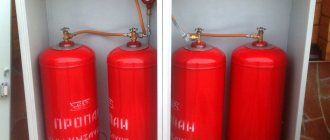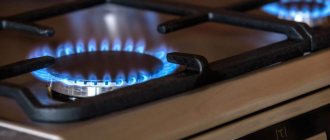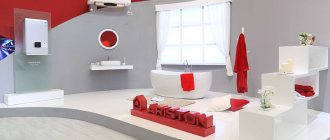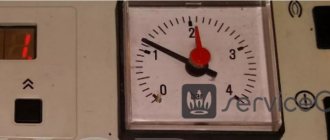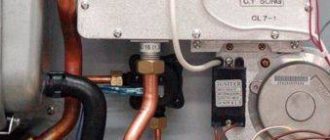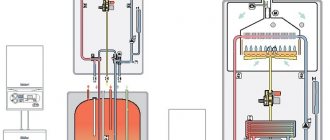Home / Tips
Back
Published: 10/23/2019
Reading time: 2 min
2
2864
Owners of country houses try to minimize gas consumption for heating the house, taking into account the overall comfort of living.
The reason for this is the increase in prices for natural fuel, which is why the owner’s family costs for paying utility bills increase.
The thermal energy created as a result of gas combustion in the boiler is additionally spent to compensate for heat loss. This is especially true in winter, when the ambient temperature can drop below -15 degrees.
- 1 Where is the gas used?
- 2 Dependence of gas consumption on internal and external factors
- 3 Useful tips for saving
The most effective way to reduce gas consumption for heating
Page 2 - continued. Start on page 1
In the homes of thrifty Europeans, heating systems are necessarily initially designed, and then immediately built with an automatic temperature control system in the house. A German or a Pole knows and understands that without automation it is impossible to ensure economical gas consumption and an acceptable level of thermal comfort in the house.
In Russia, owners often begin to realize the need for automatic temperature control after the house is built, the heating system is already installed and working, and gas bills begin to arrive.
It turns out that outside the house, the air temperature, direction and strength of the wind are constantly changing. Day or night - the outside air temperature, even during the day, often changes by a good ten degrees. The changeable wind sometimes blows through the house, sometimes it doesn’t, the fickle sun sometimes heats the house, sometimes it doesn’t. Heat loss at home is constantly changing by different amounts. In order not to bother with all this leapfrog, the owner of the house manually sets the heating temperature of the heating water on the boiler to a higher temperature, so that the temperature in the house is warmer, with a margin. And at the end of the month, he looks with surprise at the numbers on the gas bill and scratches his “turnips.” Read the comments to the article - there are many such “owners” there.
The owner learns that in order to equip the house with automatic temperature control, it is necessary to throw out some things, replace and redo the heating system, and install additional equipment. And for this you will have to buy again, drill, chisel, lay, finish, and most importantly, pay for everything. That all this automation would have been much cheaper if it had been installed immediately during the construction of the house.
And having connected a room thermostat to the boiler, the owner is surprised to observe that the temperature in the house remains constant, while the boiler does not turn on for half a day and does not consume gas. The owner is slightly panicked by such savings and asks a question in the comments - why is this?
Watch this video:
How to reduce gas consumption and pay less
First of all, as with water, electricity, etc., it is highly recommended to install a gas meter in the house. Payment for gas according to the meter is always less than the average. Therefore, if you still do not have a gas meter installed in your house, then to save money, we recommend starting with its installation.
Now as for cooking, heating rooms and preparing water. If you decide to save gas, then you need to do it wisely. For example, make it a rule not to cook small-volume dishes using a gas oven for these purposes. Sometimes, in order to bake your favorite dish, a microwave is enough. You shouldn't light the gas oven because of this.
By the way, a considerable amount of gas is used for cooking. At the same time, few people think about this and do not pay due attention to this action. When cooking food on gas, use a gentle burner setting so that it is enough to cook a specific dish.
After the water boils, reduce the gas so as not to use up too much. And remember that the highest temperature is at the tips of the flame. You should not allow the flame to envelop the dishes, as this is ineffective and, moreover, greatly damages them.
Room thermostat saves gas
To automatically control the temperature in a heated room, manufacturers recommend connecting a room thermostat - a thermostat - to the gas boiler.
Boilers of luxury categories, as a rule, are immediately equipped with a remote control unit. Installed on the wall of the room, such a unit allows you to remotely control and monitor the operation of the boiler, and also serves as a room thermostat.
A room thermostat allows you to maintain a constant temperature in a heated room with higher accuracy. With manual control, the range of temperature fluctuations is larger and deviations are more often towards higher temperatures. Every extra degree in the room leads to an increase in gas consumption for heating. In addition, using a thermostat, you can program an automatic decrease in the temperature in the house during certain periods (at night...). Refusal of manual control of heating temperature and installation of an automatic regulator to maintain the required temperature in the room can significantly reduce gas consumption for heating .
In addition, to change the boiler settings, the owner does not have to run to the boiler room. Custom boiler settings can be changed right in the house, on the thermostat.
A room thermostat or room thermostat temperature sensor is always installed in the largest room of a house or apartment.
Room thermostat saves energy
When the boiler operates without a room thermostat, the circulation pump runs constantly, consuming electricity. The room thermostat controls not only the gas burner, but also the circulation pump. The circulation pump, controlled by the room thermostat, operates intermittently, which saves energy and the life of the pump.
We carry out calculations
It is clear that fuel consumption directly depends on the power of the heating unit. The higher the power rating of the equipment, the higher the consumption will be. So, before you start calculating, it’s worth finding out what power the heating boiler is installed in the house.
Advice! When calculating the required unit power for a heating system, many use the formula - for every ten square meters of heated area there should be one kW of boiler power. This method of calculation is inaccurate, but it is the simplest and most understandable.
Calculation example
For example, if the area of the heated object is 240 square meters, then the power of the heating boiler should be 24 kW. Let's make a calculation to determine how much fuel such a heating unit consumes per month and for the entire heating season.
Advice! If you wish, you can find an online calculator that will help you calculate the consumption of blue fuel.
To calculate gas consumption per month for the heating unit in our example, it will be necessary to multiply the boiler power indicator by the number of hours in a day (24) and the number of days of use:
24 kW * 24 hour * 30 (days) = 17,280 kW/hour
Of course, this is too much, since the boiler does not operate at full capacity 24 hours a day. Therefore, the resulting figure can be safely divided by two, we get 8640 kW/hour. This is an approximate monthly consumption; if you want to know the consumption for the entire heating season, then a simple calculation is carried out.
It is necessary to multiply the monthly consumption by the number of months during which the boiler is in operation. If the season lasts 7 months, then the consumption will be: 8640 kW/hour * 7 = 60,480 kW/hour.
Advice! In the example given, gas consumption is taken into account only for the operation of the heating system; if gas is also used to ensure the operation of the hot water supply system and cooking, then the consumption will increase.
Weather temperature control reduces gas consumption
All building structures of a house have the property of thermal inertia. For example, when the air temperature changes outside, the outer walls slowly heat up and do not immediately cool down. That is, a change in outside temperature leads to a change in indoor temperature with some delay.
When adjusted using a room thermostat, the temperature of the coolant in the system will not change until it begins, for example, to rise in the room due to warming outside. Only after this the temperature of the coolant will begin to decrease, but, due to the thermal inertia of walls, radiators and other structures, the heat release will continue for some time, and the temperature in the room will always be higher than the set one.
For this reason, the accuracy of maintaining the room temperature using a room thermostat will not be very high. The range of temperature fluctuations in the house will be greater than the value specified by the thermostat hysteresis setting.
If the coolant temperature is changed simultaneously with fluctuations in the outside temperature, the accuracy of indoor air temperature control can be increased, which will increase comfort and reduce gas consumption for heating.
Weather control of indoor air temperature can be done in one of three ways:
- By connecting only the outside air temperature sensor to the boiler, without connecting the room thermostat.
- By connecting a temperature sensor and a two-position thermostat to the boiler.
- By connecting a temperature sensor to the room thermostat, if its design provides for such a possibility.
The best temperature stability, and therefore comfort and energy savings, can be achieved if you use the third method of weather control.
The first option, with only an outside temperature sensor connected to the boiler, provides a minimum of costs - no need to purchase a thermostat.
Connecting an outside temperature sensor and a two-position room thermostat to the boiler is the best option for weather control.
A boiler with an outside temperature sensor will respond to changing weather conditions, and a room thermostat will adjust the temperature of the coolant, depending on the air temperature in the room. The fact is that the temperature in the room depends not only on the heat that comes from the heating system. The temperature in the house changes if, for example, the window is open or the sun is shining through the window, electrical appliances are running, or there are many people in the room. The room thermostat will respond to all this, adjusting the temperature in the heating system.
Protherm gas boiler outdoor temperature sensor
For Protherm boilers, the plant produces an NTC type external temperature sensor with code S010075. The sensor is placed outside, on the facade of the house protected from the sun. The sensor is installed on a bracket, at some distance from the wall, so that the temperature of the wall does not affect the sensor. The sensor is connected to the boiler with a two-core copper wire with a cross-section of at least 0.75 mm2.
Dependence of resistance on temperature for the thermistor of the outdoor temperature sensor of the Proterm gas boiler
There is experience in using an NTC thermistor B57164-K 222-J, 2.2 kOhm, 5%, from Epcos, as an external temperature sensor. You can buy it in the online store. In parallel with the thermistor, you need to connect a regular resistor with a resistance of 2.2 kOhm. This is necessary so that the dependence of the resistance of the external sensor on temperature approximately corresponds to the data indicated in the table.
For weather protection, the thermistor is placed in a suitable box. The cost of such a homemade sensor with a thermistor is significantly lower than a factory sensor.
A powerful boiler is the main reason for boiling of the heating system
Basically, situations of boiling of the coolant in the heating system are caused by incorrect calculations and the choice of modification of the heating device.
The most competent and comprehensive solution to the issue in this situation would be to increase the size of the connected power of heat receivers.
Considering that the heating load in the house is fully provided, it is recommended to install an external indirect heating boiler, which will increase the circulation rate of the coolant several times, and, consequently, reduce the heating temperature.
The heating system has a rather complex structure and before assembling all the elements into a single network, it must be calculated in detail. Choosing the boiler power “in reserve” poses a threat to life in the house, due to the possible process of boiling of the coolant in the boiler and its subsequent explosion.
Thermostatic valve on the radiator reduces gas consumption
Thermostatic valve - a thermostat for a radiator reduces gas consumption for heating.
Installing a thermostat on a radiator is a mandatory requirement of building regulations. Weather control changes the temperature of the heating water in the heating system depending on the outside temperature.
A room thermostat regulates and adjusts the temperature of heating water depending on the temperature in one room where it is installed.
The room thermostat is always installed in the largest room of the house or apartment. The temperature in other rooms will differ from the one that is necessary, in one direction or another. For example, in order to save gas, it is beneficial to keep the temperature in rarely visited rooms lower.
The temperature in other rooms can be controlled using thermostats installed at the heating water inlet to the radiator. A thermostatic valve or an electronic radiator thermostat is used as radiator thermostats.
The thermostatic valve regulates the flow of heating water through the radiator so that the room temperature remains constant, set on the thermostatic head scale. The control head of the thermostatic valve contains a bellows filled with liquid or gas. When the temperature in the room changes, the temperature of the liquid (gas) changes. As a result of thermal expansion of the liquid (gas), the bellows changes its position and acts on the valve stem on the radiator pipe.
On sale you can find thermostatic valves with a remote temperature sensor . Such devices provide a more stable room temperature, since the influence of a closely located radiator and window is eliminated.
Electronic radiator thermostat
Electronic programmable thermostat for heating radiator.
Powered by AA batteries, 2 pcs. Temperature adjustment from 5 °C to 35 °C. Hysteresis ±0.5 °C. LCD display. The electronic radiator thermostat, as well as the thermostatic valve head, is mounted on the control valve on the radiator pipe. Compared to a thermostatic valve, it has many more control functions.
A radiator thermostat consists of a built-in or remote temperature sensor and a servo drive, which opens and closes the valve valve on the radiator.
In a programmable radiator thermostat, you can select the temperature mode for day and night, for different days of the week. This allows for greater comfort and gas savings . For owners of a country house, a programmable thermostat will maintain an economical heat mode on weekdays, and before arrival it will switch to warm-up mode in advance.
An electronic programmable radiator thermostat can provide:
- Indication of room temperature.
- Low battery indication.
- System fault indication.
- Operating mode indication.
- Setting an economical and comfortable temperature regime.
- Setting a schedule for alternating comfortable and economical modes for each day of the week.
- Child lock function.
- Room ventilation function.
- Valve protection against souring.
- System frost protection function.
Dependence of gas consumption on internal and external factors
Russian gas fuel consumption standards are based on Soviet technical standards. This is an average indicator for the former territory of the Soviet Union, which takes into account:
- ambient temperature;
- wall material and thickness;
- type of window structures installed in the house;
- method of room ventilation;
- technical level of boilers.
But in a specific case, these norms do not always work. For example:
- during the construction of the building, walls with increased thickness were created, or a material with minimal heat loss characteristics was used;
- entrance doors and wooden windows were replaced with metal-plastic ones;
- When equipping the building, comprehensive insulation was carried out (for example, the walls, attic and basement were modified).
The factors given above are external. The impact of each factor from the specified list has a direct impact on gas consumption in relation to current technical standards.
Therefore, the first step towards additional savings in winter is the purchase and installation of a gas meter.
There are also internal factors that further reduce gas consumption, especially in winter.
- Dismantling an old gas boiler made in the Soviet Union. Instead, the owner integrates a modern heat generating unit into the room, complemented by a circulation pump.
- If a country house was built during the Soviet Union, there will probably be steel or cast iron radiators inside it. Instead, it is necessary to install new aluminum or bimetallic analogues. Additionally, a floor heating system (water or infrared) is installed, which supports temperature regulation by zone.
- Installation of an electric boiler and air conditioner, which will work in tandem with a forced ventilation system.
- The use of alternative heat sources together with gas boilers.
What specific result is achieved? First of all, the overall effectiveness of the measures listed above varies from 30 to 50 percent, depending on the characteristics of the particular case.
Official Internet sources often contain figures at the level of 70-80 percent. This figure is probably overestimated, so you cannot rely on it.
Automatic temperature control in a house with heated floors
In a house with heated floors, it is necessary to have three automatic temperature control systems : 1 - heated floor according to the air temperature in the room, but with a limitation of the floor temperature; 2 - radiators based on room air temperature; 3 - weather control of the boiler based on outside air temperature.
As you know, a warm floor can be either “comfortable” or “heating”.
"Comfortable" heated floor
slightly warms the surface and provides a pleasant feeling when a person is on the floor. The main heat supply to the room is provided by radiators. For a comfortable heated floor, it is necessary to maintain a constant temperature of the coolant.
"Heating" heated floor,
In addition to comfort, it provides complete heating of the room.
In the Russian climate, the relatively small thermal power of a heated floor makes it most often suitable only for comfortable heating.
An air temperature sensor in the thermostat housing and a sensor in the floor provide room temperature regulation and protect the floor from overheating
In a house with a comfortable heated floor, it is necessary to have three automatic control systems to control the temperature .
One system that regulates the operation of a warm floor must be controlled by the air temperature in the room until the temperature of the floor surface reaches a comfortable level. That is, in the off-season the house will be heated with the heat of the heated floor.
the automatic radiator control system comes into effect . Radiators will heat the air in the room, adding their heat to the heat that will constantly come from the heated floor.
The heating mode of the coolant by the boiler must be regulated by another automatic weather control system that responds to the outside air temperature .
Considering that the underfloor heating system has a high inertia (it heats up slowly and cools down slowly), it is recommended to use weather automation to control its operation. Then the temperature of the coolant supplied to the system will be adapted to the outside temperature. Due to this, along with changes in outside temperature, the temperature of the coolant circulating in the floor changes.
The mixing unit with circulation pump is on the left. On the right, a manifold of underfloor heating pipes is connected to the mixing unit. Control valves with a servo drive are installed on the manifold. The valve is controlled through a servo drive by a thermostat, which regulates the supply of coolant to the heated floor circuit depending on the temperature of the floor surface and the air temperature in the room.
Each room with a “warm floor” is at least one circuit (one pipe loop). All these circuits must somehow be combined into one and connected to a boiler or other heat source. Both ends of the pipe of each heated floor circuit are connected to the manifold.
To regulate the temperature of the heated floor, it is necessary to select and install a manifold equipped with servo drives on the control valves.
A servo drive is a device that, when electrical current is supplied to it from the thermostat, acts on the valve, opening or closing it. The servo acts as a switch, completely opening or closing the valve. The surface temperature of the heated floor will be maintained with an accuracy of +/- 0.5 - 1 °C.
What happens if the boiler power is incorrectly selected?
In cases where a mistake is made and the choice of boiler unit is not made correctly, you need to understand how to get out of this situation correctly. In fact, there are 2 options for incorrectly calculating the thermal power of a heating unit.
The first is that the thermal performance of the unit in relation to the total heated area of the house is chosen to be very small in order to be able to compensate for the thermal losses of the object, and the second is when the heating unit is purchased with a significant margin. In the first option, even when the device is operating at full load, the temperature in the rooms remains unacceptably low and does not rise. There is no emergency here; the only negative is the cold in the house.
In order to solve this problem, you still need to calculate the required size of the heating output of the unit and only then will it be possible to choose the right solution.
If the power deficit is not large, it may be compensated by additional insulation of the external walls of the house by replacing window units.
If this is not enough, then you will have to buy a new device as the main one for heating, and leave the first one for heating hot water and “standby heating”, when outside temperatures are above zero or there are no residents in the house. This way you can get a very efficient heating system.
The situation is much worse when the calculation of the heating device is carried out with an excessive reserve of thermal power. First of all, this will cause a constant high and uncomfortable temperature in the room, even when the burner is operating at the lowest load, everything in the house will be unbearably hot.
If the device has an automatic control principle, then the boiler clocking process will begin when the burner is constantly turned on/off. But the most dangerous phenomenon that occurs when there is an excess of power is that the device will begin to generate many times more thermal energy than is needed by the heating system and the water in the unit will boil, during which steam of large volume and explosive force is formed, which can lead to an explosion of the unit .
Thermostats for heated floors
A thermostat is a device that measures the temperature of something, compares this temperature with a predetermined temperature and, depending on the result of the comparison, commands the servo drive to turn the control valve on or off. Thus, by turning on or off the heat supply, the thermostat maintains the temperature of something with minimal deviations from the set value, usually with an accuracy of +\- 0.5 oC.
To measure temperature, the thermostat may have a temperature sensor built into the body of the device. The temperature sensor can also be remote. The remote sensor is connected to the thermostat by wires.
The thermostat always has buttons or wheels with which you set the temperature, the stability of which it must ensure. All thermostats have an indication of the current state - “heating on” or “heating off”.
The thermostat, depending on the method of connection with the actuator, can be wired or wireless.
The lowest budget option is a wired thermostat. The device itself is installed in a room in which it must maintain temperature. A heated floor collector with servo drives can be installed in another place, for example, in a boiler room. These devices are connected to each other by thin wires.
The wireless thermostat transmits a control command to the collector servo drive via a radio channel. To do this, there is a radio transmitter in the thermostat housing, and a radio receiving unit is installed near the collector. Installing a wireless thermostat can be beneficial when automation work is carried out in an already built house - there is no need to lay wires and disturb the finishing of the premises.
Thermostat with the function of regulating room temperature and heated floor temperature. Works with two temperature sensors, one in the device body, the other remote, in the heated floor.
To regulate the air temperature and the temperature of the heated floor in accordance with the algorithm - we regulate the air temperature in the room, but do not allow the floor to heat up above the set temperature, you need a thermostat that has the appropriate functions.
Thermostat for underfloor heating:
- Must work with two temperature sensors: a built-in air temperature sensor and an external heated floor temperature sensor.
- The thermostat should have the ability to set the air temperature and the heated floor temperature separately.
- There must be a control algorithm based on air temperature with a limitation on the surface temperature of the heated floor.
Switching module for connecting several underfloor heating circuits to one thermostat.
One thermostat can control several actuators installed on one manifold. The thermostat and servo drives are connected through a special unit - a switching module.
Choosing a room thermostat - thermostat
Let's look at the choice of automation devices for controlling the heating system in a private home using the example of the Protherm brand equipment manufacturer.
A room thermostat installed in a room measures the current air temperature and, if the temperature deviates from the value set in the settings, sends a control signal to the boiler.
The room thermostat, which controls the operation of the boiler, is installed in the largest room of the house . Radiators in the room in which the thermostat is installed should not have valves that regulate coolant flow. In other rooms, a thermostatic valve must be installed on each radiator, which regulates the coolant flow through the radiator depending on the temperature in this room.
In heating systems with heated floors and radiators, the automatic air temperature control system is more complex.
Read: “Automatic control of air temperature in a house with heated floors and radiators .
The signal from the thermostat to the boiler can go via wires, or maybe via wireless radio. In the latter option, a unit for receiving a radio signal from a wireless thermostat is installed on the boiler.
It is recommended to use thermostats of the same brand to control Protherm boilers. The Protherm brand boiler manufacturer produces several modifications of room thermostats for its gas boilers.
The most economical heating boilers
How to reduce gas consumption in the heating system? First of all, you need to choose a device that is suitable for your home. Why is that? Because only taking into account the area of the room, wall material, number of windows and other factors can one calculate the required power and performance of the boiler. Only then will the equipment effectively release heat without wasting unnecessary energy.
If you want to save on gas consumption, then connect only to the public mains. Using cylinders is very expensive. What criteria influence savings:
- Design features;
- Efficiency factor (efficiency);
- Power of equipment;
- Fuel quality;
- Optimal mode.
Let's go through each point in more detail.
Equipment design
Heating boilers come with one and two circuits. A single-circuit device is designed only for heating the room, and for hot water supply (DHW) you will have to additionally connect a boiler. But dual-circuit models already include everything necessary for heating the house and for hot water supply.
To calculate savings, pay attention to the type of combustion chamber. The open chamber takes air from the room to maintain combustion and remove gases. The closed one forcibly brings in air from the street. Combustion products are removed by a fan. This principle promotes complete combustion of fuel, as well as minimal CO2 emissions.
Closed-type devices are connected to a coaxial chimney. Its tube-in-pipe design traps more heat. Therefore, the air from the street is heated, which increases combustion efficiency.
Effect of efficiency
Today the market offers the buyer convection and condensation boilers. Which one is more economical? It is considered to be condensation because it uses the energy of condensate. When taking into account additional energy, a conventional unit has an efficiency of 92-94%, and a condensing unit has an efficiency of 100-102%.
Standard operation involves burning fuel and venting gases to the outside that are at a high temperature. Combustion products contain impurities and moisture. Passing through the heat exchanger, the gases reach 60°. This causes sediment to form and accumulate in the tank. The process releases energy, which is used by the condensing device. It is believed that this can save up to 20% of fuel. But even here there are pitfalls. Such units are installed in low-temperature systems with heated floors.
There are also a number of other nuances that we described in the article “What is a gas condensing boiler”.
What affects the efficiency of a convection boiler:
- Physical underburning. When air burns instead of gas. The quality of the fuel affects;
- Chemical underburning. Depends on the amount of carbon monoxide during the combustion process;
- Poor insulation and wall insulation.
How to set up optimal performance:
- Clean the system at least once a year. Remove scale from the heat exchanger, soot from the burner and tubes;
- Place a damper on the pipe to restrict air flow;
- Clean soot from combustion chamber parts, otherwise gas consumption will increase.
Equipment power
The power of wall-mounted and floor-standing boilers is different. Wall-mounted heaters heat rooms up to 300 m². But floor-mounted ones can heat huge areas. The optimal coolant temperature depends on the power. Why is this indicator important?
There is such a thing as boiler clocking. This is the frequency of heating turning on and off depending on the temperature drop. A device that is too powerful will not be able to operate in optimal mode - the manufacturer takes this into account when indicating the efficiency of the model. The appliance will turn on frequently and the rest interval will be short.
Weak equipment, on the contrary, will quickly wear out, as its work will be carried out to the limit of its capabilities. Before purchasing, pay attention to the optimal power - this is 75% of maximum performance.
Two-position thermostats - thermostats for a gas boiler
The electromechanical two-position room thermostat Protherm Exabasic for a gas boiler is simple, cheap, but temperature fluctuations in the heated room will be significant - about 2-3 ° C.
The electronic two-position room thermostat Protherm Exacontrol provides higher accuracy and stability of maintaining the temperature in the room, and has the function of protecting the heating system from freezing. The display shows the current room temperature.
Electronic two-position programmable room thermostat - thermostat Protherm Thermolink S
Thermolink S is an electronic two-position programmable controller, differs from previous models in that it allows you to adjust the temperature according to one week program with the possibility of combinations of three different time intervals (morning, afternoon, evening).
Weekly program for regulating heating temperature in a house or apartment using the Protherm Thermolink S room thermostat
In addition, it is possible to set one of three temperature modes: “Comfort”, “Eco” (economy) or “Vacation” mode.
The Thermolink S controller supports the function of protecting the heating system from freezing when the room temperature drops to 3°C.
The display shows the current room temperature, as well as the time and day of the week.
Features of operation of a boiler with a two-position thermostat
On-off thermostats have a relay with contacts at the output. The contacts can be in one of two positions: closed or open. Connected to the boiler, closed thermostat contacts switch on the boiler heating mode. When the contacts open, the heating mode is switched off. The boiler operates in cycles - on/off. There are no changes in the heating mode settings on the boiler itself.
The cyclical operation of the boiler under the control of a two-position room thermostat can hide the clocking of the boiler, which occurs due to a significant discrepancy between the capacities of the boiler and heating devices (read the beginning of the article about clocking).
Many even argue that boiler clocking can be eliminated not by adjusting the gas valve, but by installing a room thermostat.
However, if the boiler power significantly exceeds the power of the heating devices, then the frequency of operation cycles of the boiler with a two-position thermostat increases. The boiler turns on and off more often. In addition, the range of temperature fluctuations in the room expands.
Correct adjustment of the power of a gas boiler is also necessary when the boiler is operating under the control of a room thermostat.
The sensitivity of the electronic two-position room thermostat is 0.5 °C. The thermostat switches contacts when the room temperature changes by half a degree.
Interface boiler temperature controllers
Programmable thermostat Protherm Thermolink P
Room programmable thermostat Protherm Thermolink P with interface (eBus) for gas boiler Protherm Gepard (Panther)
The programmable thermostat Protherm Thermolink P allows you to set the temperature according to one week program with the possibility of combinations of 3 different time intervals (morning, afternoon, evening).
It is possible to set one of three heating temperature modes: “Comfort”, “Eco” or “Vacation” mode. It is possible to adjust the hot water temperature.
The Thermolink P thermostat supports the function of protecting the heating system from freezing when the room temperature drops to 3°C.
The display shows the current room temperature, as well as the time and day of the week.
The Thermolink RC interface controller is a modification of Thermolink P with similar properties and parameters, but with a wireless connection to the boiler.
The difference between the interface Thermolink P and the two-position Thermolink S
The Thermolink P room temperature controller is connected to the boiler via the eBus interface. This bus is used to exchange data between the microprocessors of the thermostat and the boiler. The thermostat has the ability to change boiler settings.
S two-position thermostat maintains the required temperature in the room by turning the boiler on and off at a certain moment.
The Protherm Thermolink P with interface (eBus) provides room temperature control by changing the boiler settings - the boiler burner power and coolant temperature change. The boiler operates continuously, not in cycles.
In addition, to change the boiler settings, the owner does not have to run to the boiler room. Custom boiler settings can be changed directly on the thermostat. For example, adjust the hot water temperature. Automatic boiler diagnostic codes are also displayed on the thermostat display.
The interface controller can work in conjunction with an external air temperature sensor connected to it.
Hot water priority
In the hot water priority mode, we observe a clear sequence of actions and cyclic switching on for heating. If you want to turn on one of the hot water taps, the boiler will forget about heating and begin to heat the water. This is called hot water priority.
The heating works around the clock, the boiler knows when to turn on and off, maintaining the required temperature in the house. The need for hot water is much less frequent than the need to heat a house. When you turn on the water, the house is “already warm,” but the water is “still hot.” Therefore, priority for heating hot water is higher than for heating.
In most modern gas boilers, the water temperature can be adjusted separately in the range from 35 ºC to 55 ºC. The procedure is similar to the heating procedure. Set the appropriate temperature and use hot water.
Setting weather control on the boiler
In order for the temperature in the house to remain constant, the temperature of the heating water in the system, when the outside temperature changes, must change according to a certain law. This pattern is determined by the magnitude and nature of heat loss from the building, as well as the parameters of the heating system.
The dependence of the heating water temperature on the outside temperature is depicted on the graph as a heating curve. The slope of the heating curve is completely individual for each building.
Heating curves for some parameter values in line d.43 of the service menu of the Protherm Gepard (Panther) boiler..
To work with an outside temperature sensor connected to the boiler, the heating curve for the house is selected in two steps.
Step 1. In line d.43 of the service menu, select the parameter that sets the slope of the heating curve (in the graph above). Factory setting of the parameter =1.2. Select a parameter that corresponds to the heating curve passing through the known intersection point on the graph of the heating water temperature and the outside temperature. These temperatures (this point) are determined by calculation. Often calculations are not done and this point is not known in advance.
Typically, the heating curve slope parameter in line d.43 is selected empirically. Leave the factory setting of the parameter in line d.43 and observe in which direction the room temperature changes when the outside temperature fluctuates. If, as the temperature outside decreases, the temperature in the room increases, then it is necessary to reduce the slope of the heating curve, i.e. decrease the value of the parameter in line d.43, and vice versa. The task is to select a parameter value at which a change in the outside temperature will not lead to temperature fluctuations in the house. At this step, the main thing is to achieve stability of the temperature in the room, without paying attention to the absolute value of this temperature.
Step 2. In line d.45 of the service menu, select the base temperature of the heating curve in the range of 15 - 25 oC. Factory setting of the parameter =20. The parameter in line d.45 sets the absolute value of the room temperature. If, after selecting the slope of the heating curve in step 1, the room temperature is stable but low, then the temperature parameter in line d.45 is increased, and vice versa. In this case, the heating curve on the graph rises or falls, but its slope does not change.
If you call line d.47 in the service menu, the display screen will display the temperature, which is measured using an outside temperature sensor.
Read: How to enter the service menu of the Protherm Gepard (Panther) boiler
Selecting weather-dependent automation for a gas boiler
To save gas, many residents of private houses are beginning to change their windows to better ones, as well as insulate the roof and walls of the house. But such actions require large expenses. There is a cheaper option to save gas. You can save fuel by installing weather-dependent automation. For example, if the outside temperature is -20 degrees, the boiler will heat the coolant to 70 degrees. If the temperature outside becomes even lower, the boiler must operate at even higher power. This requires human participation. Temperatures are usually higher during the day than at night. And if you set a certain operating mode during the day, then at night the temperature in the house will be uncomfortable. And if you set the power with a reserve for greater heating at night, then it will be hot during the day, and the boiler will consume 15% more than necessary. Thanks to the outdoor temperature sensor, it will maintain the temperature of the gas boiler depending on the temperature outside.
Weather dependent automation has the following advantages:
- You do not need to independently regulate the power of the gas boiler.
- The room will have a comfortable temperature.
- No gas will be wasted.
- The cost of such a device is only 1,500 rubles.
- Installing the sensor is very simple.
For more efficient operation, it is recommended to choose an outdoor temperature sensor from the same manufacturer as the gas boiler.
Connecting the thermostat and outside air temperature sensor to the boiler
The wires from the room thermostat - thermostat are connected to the terminal block marked as X17 (black in the figure on the left) in the 24 V compartment of the control panel of the Protherm Gepard (Panther) gas boiler.
The wires from the two-position thermostat are connected on the block to the RT terminals, instead of a jumper.
The wires from the Thermolink P interface thermostat are connected to the same block, but to the terminals marked “e-Bus”. The jumper between the RT terminals is left in place.
An outdoor temperature sensor can be connected to the Toext terminals.
Connecting a two-position wireless thermostat to the boiler - video
The wireless room thermostat consists of two blocks.
The executive unit is installed near the boiler and connected to the boiler by wires, to the same terminals as a conventional wired thermostat. To power the executive unit, it is also connected to a 220 volt power supply.
The measuring (control) unit with a display is mounted on the wall of a heated room. The signal from the measuring unit goes to the executive unit via a radio channel.
Tips for the developer
How to reduce the high gas consumption of a boiler for heating a house:
- Choose the power of one gas boiler that is minimally necessary to compensate for heat losses at home. When installing two boilers, their total power must be equal to the minimum required.
- In order to save gas and comfort, it is beneficial to use a heating and hot water system with a single-circuit boiler and boiler. When the heating system power is less than 15 kW. It is better to avoid using a double-circuit boiler; a system with a boiler will be most profitable.
- Choose a gas boiler with an open combustion chamber, atmosphere.
- When choosing a boiler brand, among other characteristics, be sure to evaluate the boiler efficiency indicated in the technical documentation.
- Clean the boiler heat exchanger to remove soot annually.
- Monitor the serviceability and immediately eliminate defects in the air supply and flue gas exhaust systems of the boiler.
- Be sure to connect a room thermostat and an outdoor temperature sensor to the boiler. Installing a simple two-position thermostat and an outdoor temperature sensor will pay for itself in one to two years.
- Install a thermostatic valve on each radiator in all rooms (except the room with a room thermostat). This will allow many rooms to avoid overheating and maintain a lower temperature.
- Equip rooms with heated floors with automatic room temperature regulators with protection against floor overheating.
Only in this way, bit by bit, having fulfilled these conditions, can the gas consumption associated with the operation of the heating system be reduced to a minimum.


